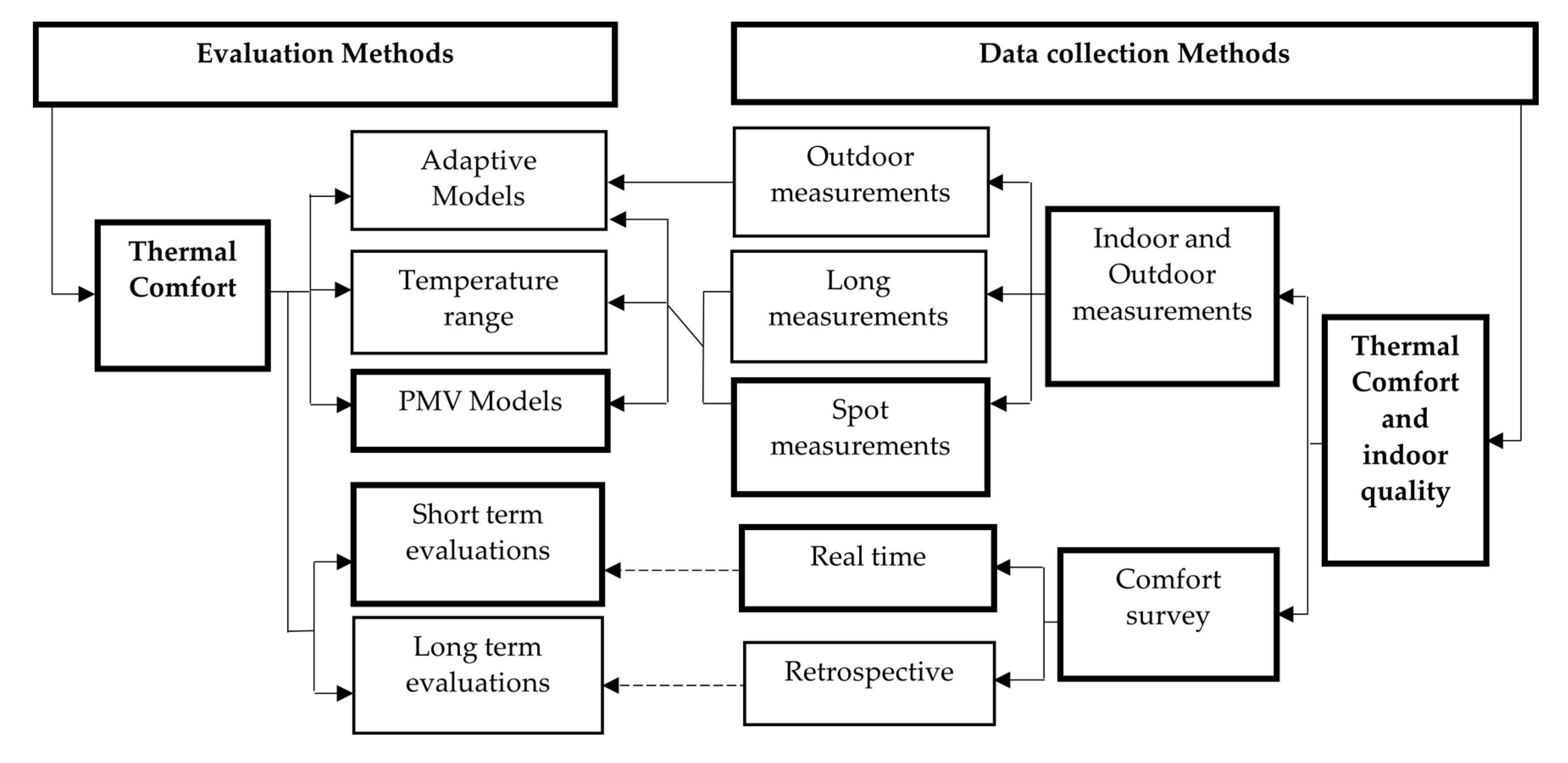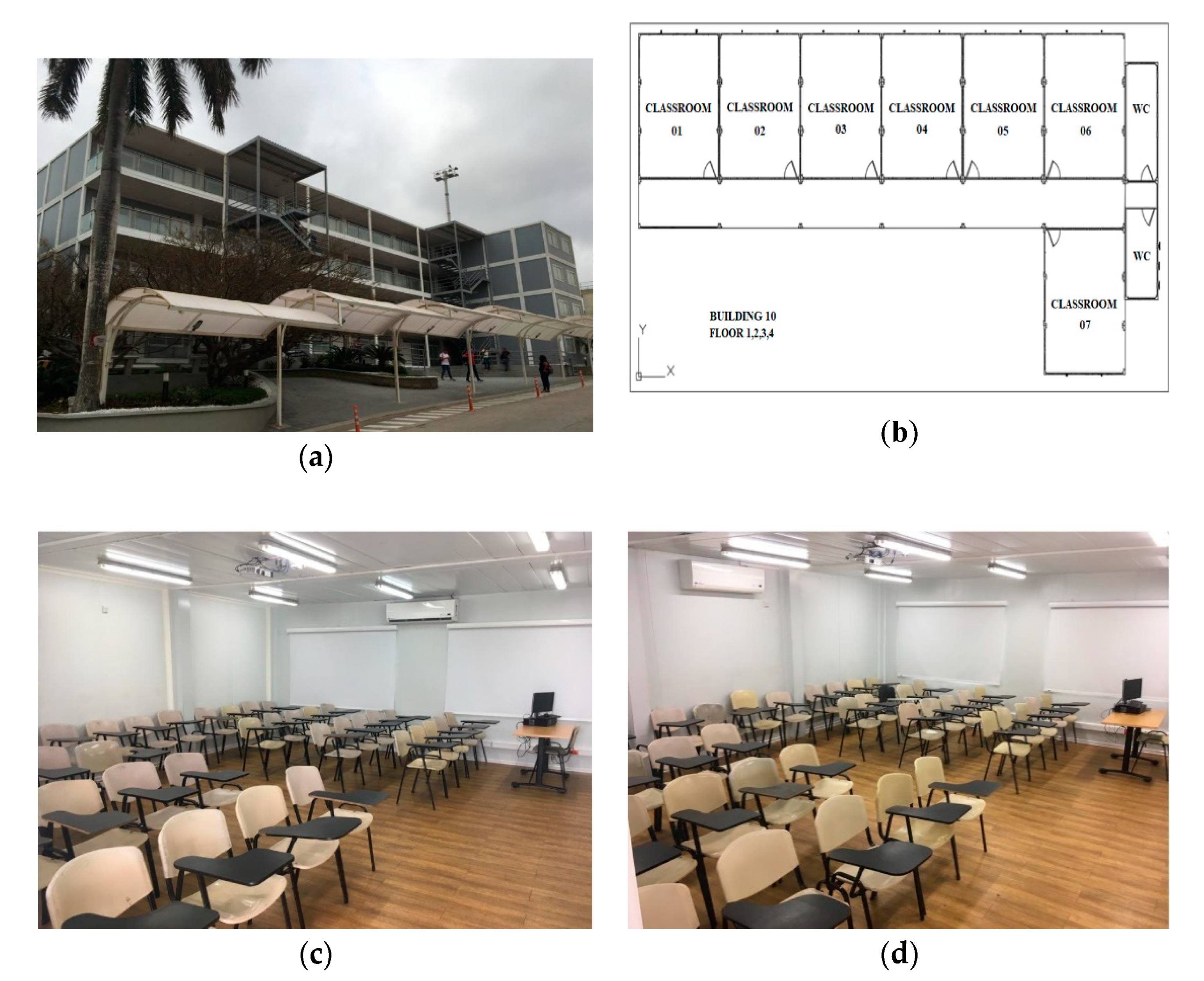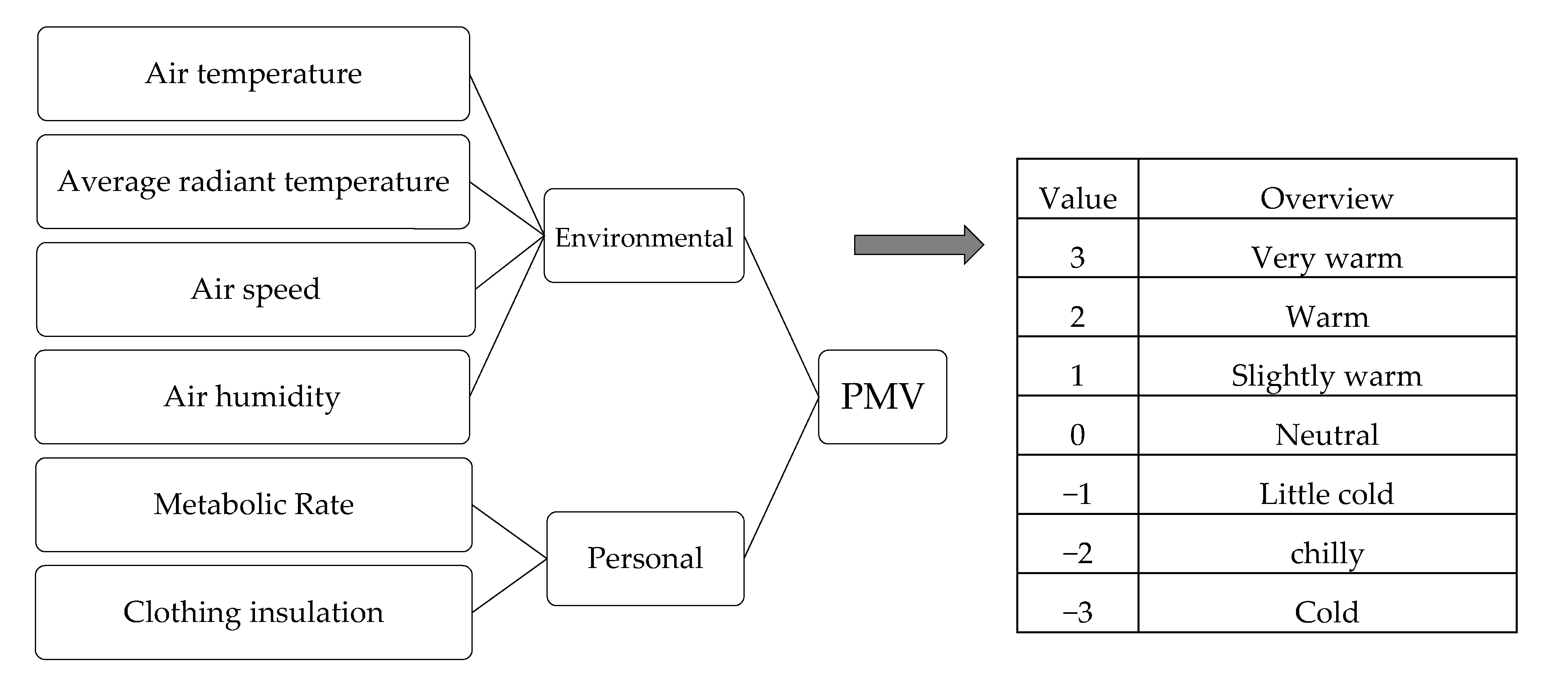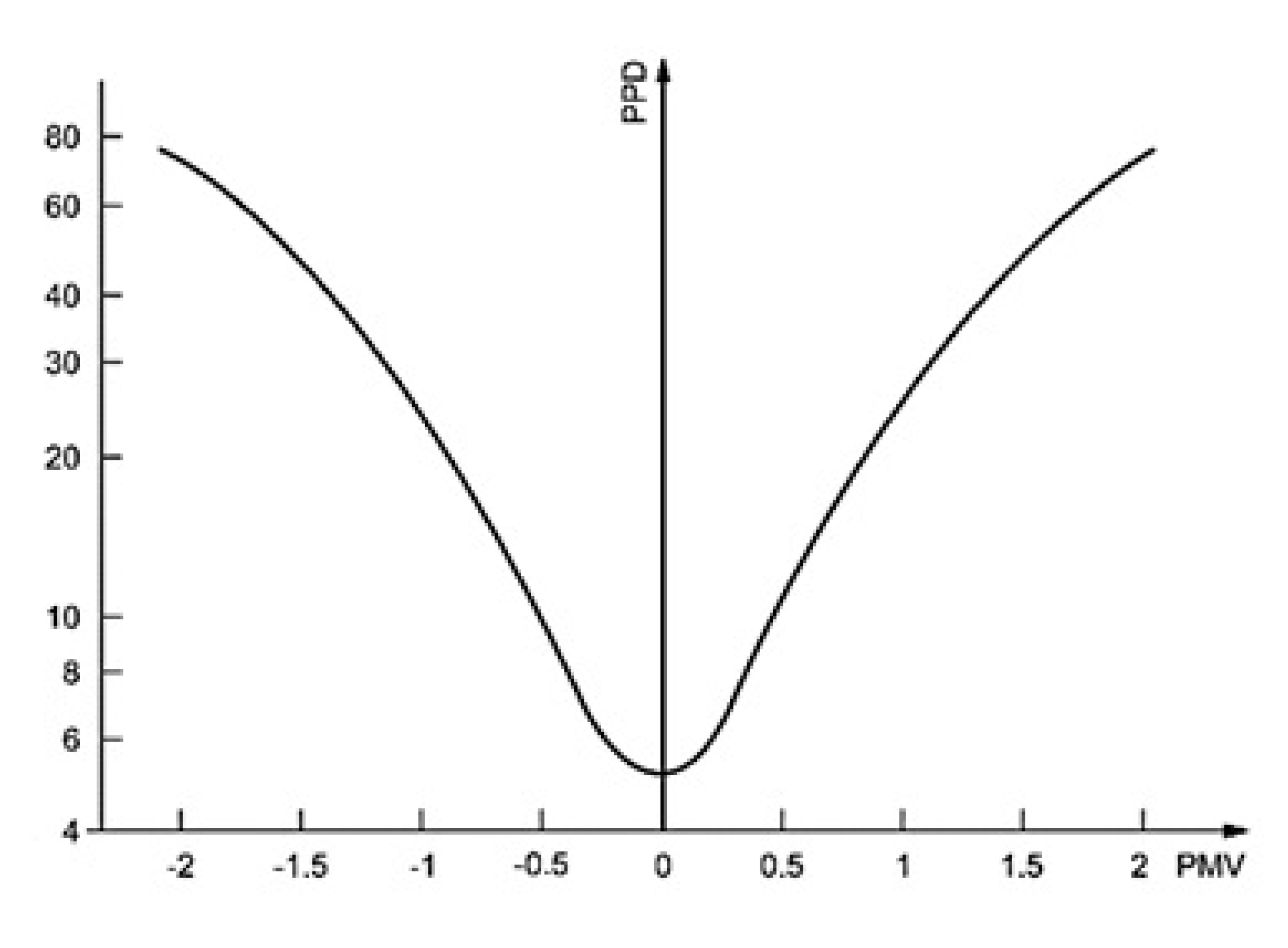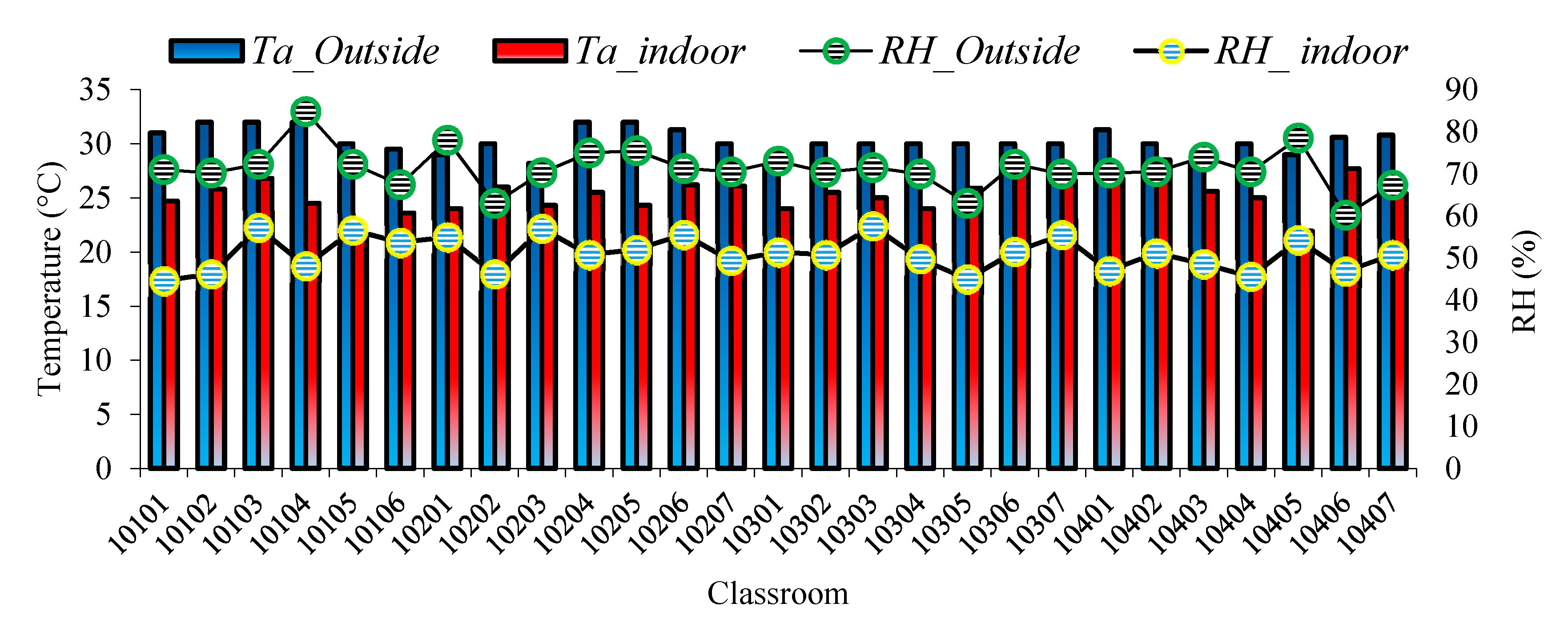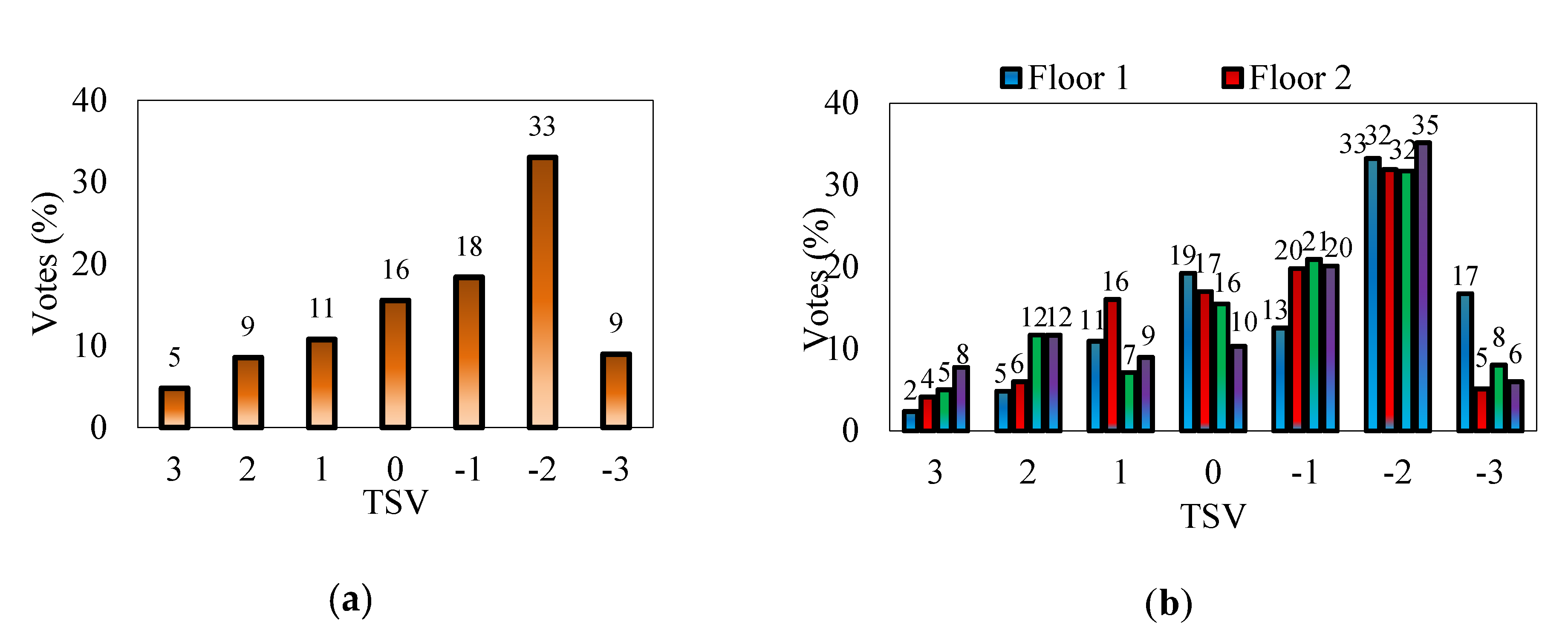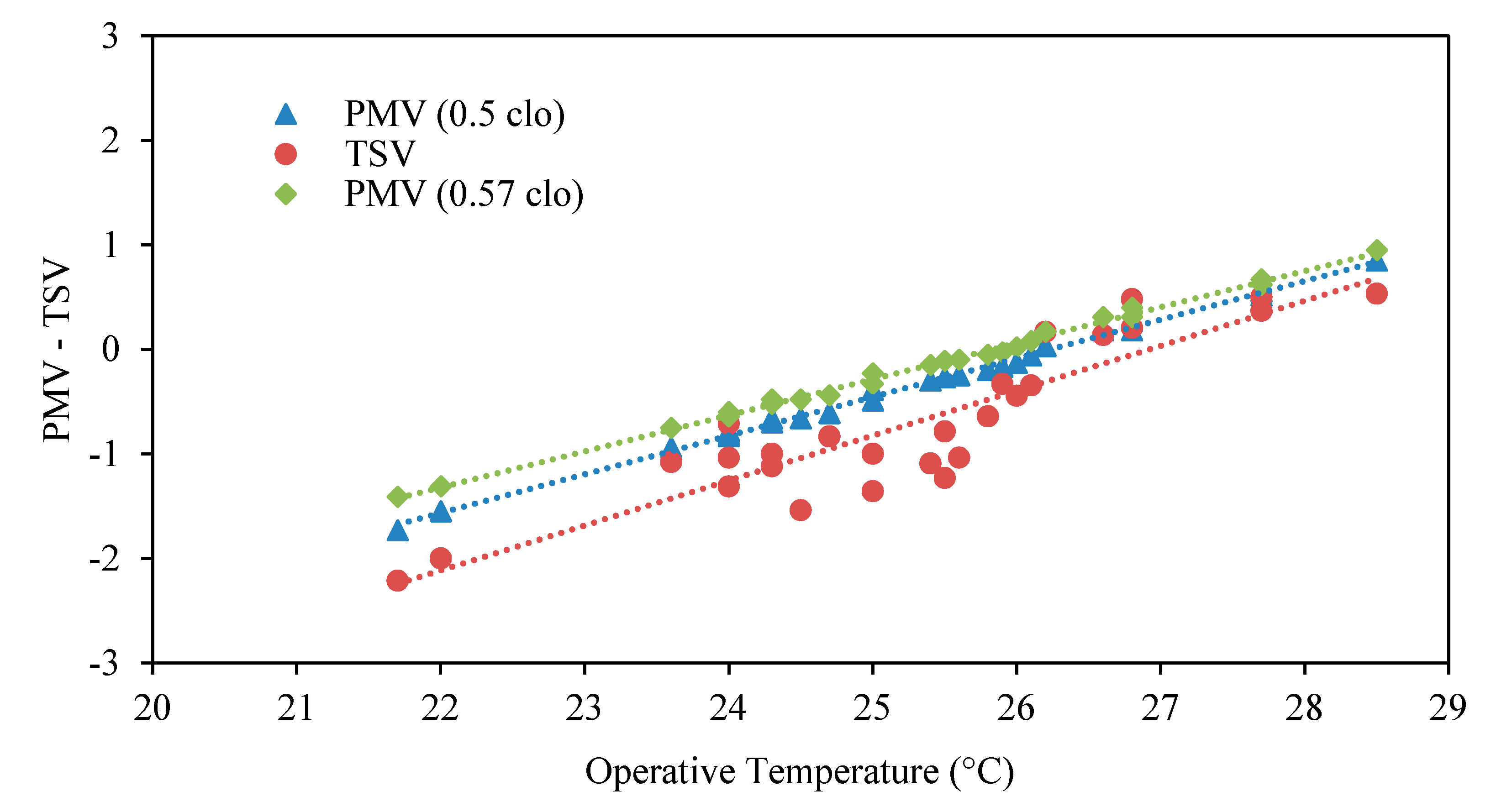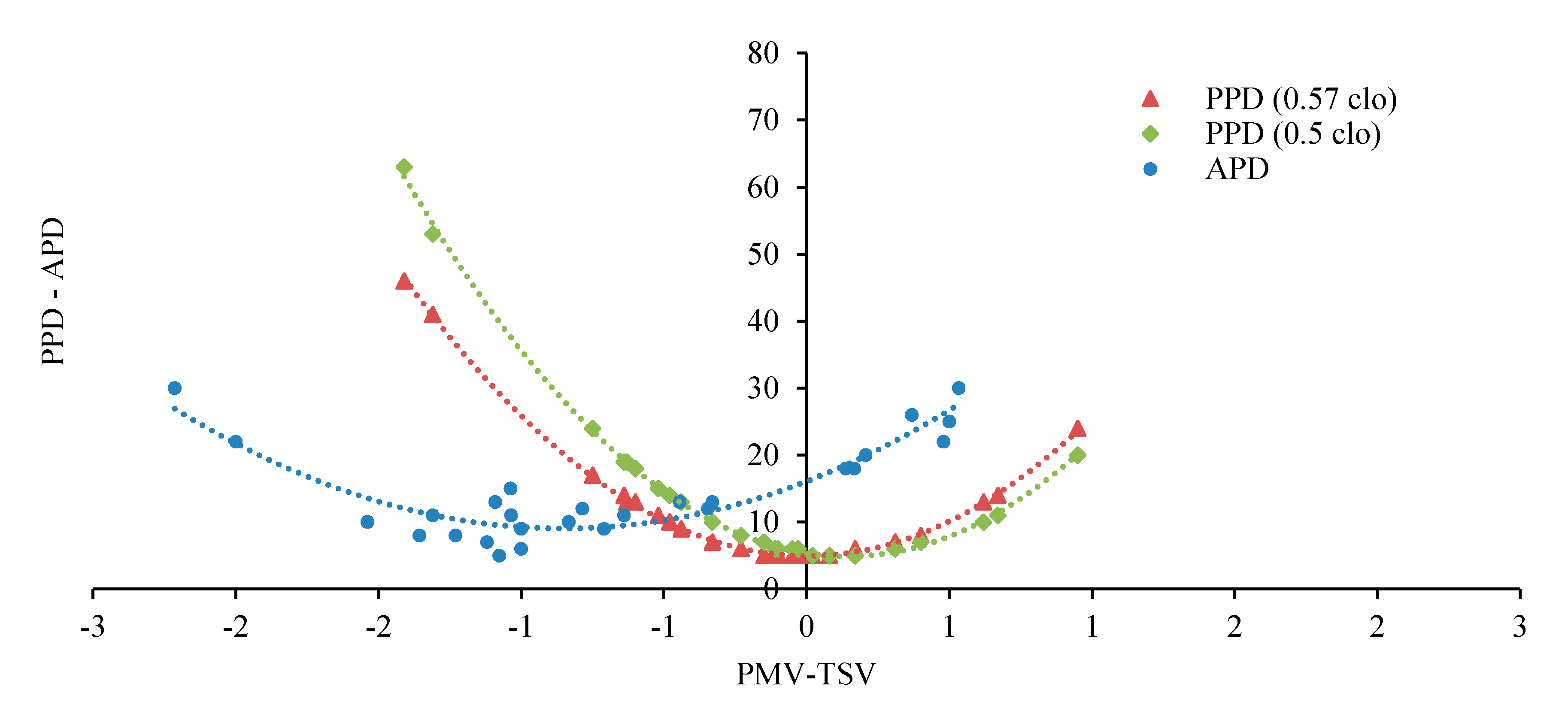1. Introduction
A suitable thermal environment for classrooms in colleges and universities impacts thermal comfort, learning performance, and the building energy consumption. Students spend a lot of time in the classroom, and studies have shown the importance of thermal comfort in student achievement [
1,
2,
3,
4]. Thermal comfort is established as a personal perception of the thermal environment [
5,
6] and it is characterized as the neutral sensation experienced by the person in relation to a given thermal environment, avoiding sweat [
7,
8,
9]. Expectations of thermal comfort depend on where the person is located, and the climatic conditions that exist inside and outside the enclosure [
10,
11,
12,
13]. According to Jiang et al. [
1], the discomfort related to feeling hot or cold has a negative effect on the well-being of participants. However, the well-being of participants decreases more noticeable when environments are colder.
Indoor thermal comfort models have been the basis for the development of international indoor environment quality standards in new and existing buildings [
14,
15,
16,
17]. For instance, the ASHRAE 55 Standard for “Thermal Environmental Conditions for Human Occupancy”, combines environmental and personal factors in indoor areas to ensure acceptable thermal comfort conditions for most occupants. In addition, when areas are mechanically conditioned, the Fanger model, which is proposed in this standard, is widely used at an international level [
5]. The ISO 7730 Standard for “Ergonomics of the thermal environment” [
18], provides the analytical determination and interpretation of thermal comfort, while the EN 16798-1:2019 for “Energy performance of buildings—Ventilation for buildings—Part 1: Indoor environmental input parameters for design and assessment of energy performance of buildings addressing indoor air quality, thermal environment, lighting and acoustics” [
19], specifies the design criteria, evaluation, and parameters involved in thermal comfort and indoor air quality for buildings. In Colombia, the NTC 5316 Standard for “Thermal environmental conditions for human occupancy” [
20] establishes the methods for evaluating and setting the requirements that must be fulfilled in order to maintain adequate thermal comfort in indoor environments, and it is an identical endorsement by transcription to the ANSI/ASHRAE 55 standard.
In order to study the thermal comfort in enclosures, Fanger proposed a heat balance model that allows predicting the acceptability of the occupants of a building for a given thermal environment [
21]. In this case, the model proposed by Fanger leads to the definition of the well-known Predicted Mean Vote (PMV) and the Predicted Percent Dissatisfied (PPD), combining thermal environmental variables, activity, and insulation of the clothing, which were first incorporated into the international ISO Standard in 1984 [
22]. According to Djongyang et al. [
23], laboratory studies carried out by Fanger are able to provide static and consistent conditions for measurements that are not possible in field studies, however field studies are preferable to those in climate chambers [
24]. Furthermore, several researchers suggest that the methodology proposed by Fanger is useful for measuring thermal comfort in closed environments, where the occupants are exposed to long working or academic schedules, and it allows for alternative improvements to be proposed [
23,
25].
Several studies have been carried out to determine the thermal comfort temperature preferred by students at universities. According to Aghniaey et al. [
21], in order to achieve the optimal cooling temperature set point, and thermal environments that are comfortable and acceptable, field studies should be carried out under actual conditions. Field studies in air-conditioned classrooms have been investigated, such as the one carried out in Taiwan by Hwanga et al. [
26], in 2006, applying the ASHRAE methodology, field studies were carried out in 26 air-conditioned classrooms, surveying 1294 people from seven universities, obtaining an acceptable temperature value of 24.7 °C. In Brazil, the research carried out by Buonocore et al. [
27] leads to a reflection on the excessive use of air conditioning systems, commonly found in university classrooms, causing an over-cooling of indoor environments. Instead of providing thermal comfort to students, these systems cause discomfort and unnecessary energy costs. The field study carried out in [
27] is applied in a hot-humid climate, in 16 university classrooms, and with 1030 surveys done, obtaining that the best thermal conditions in the air-conditioned classrooms were between 23 °C and 24 °C.
Thermal comfort studies have also been carried out with the aim of achieving a balance between the energy efficiency of the building and thermal comfort in classrooms [
26,
28,
29,
30]. Due to the size and dynamic environment of buildings, reducing energy consumption while providing the comfort that users demand is currently a challenge. A study carried out at the University of Bordeaux in France determined that some of the factors that influence the variability of energy consumption are climatic factors and the feeling of thermal comfort by occupants. [
31]. Similarly, the evaluation of the thermal comfort and energy performance in an educational building in Valencia, Spain have also been reported [
32]. The studies described above indicate that the thermal discomfort may be due to misuse, design errors, and inadequate operation of the air conditioning systems, hence the importance of studying the thermal comfort of a building and its causes. As the comfort zone is wider and depends on the outside temperature, the air-conditioning systems need to be activated less, thereby reducing energy consumption [
6,
30,
33]. From the analysis made in the literature review regarding field studies from different regions, it is possible to agree with Campos [
32], that the indoor environment conditions associated with thermal comfort can be significantly affected by parameters related to climate, occupancy, and the energy technologies used. Therefore, the importance of the evaluation of the thermal environment in actual conditions is highlighted.
The present work is part of a research project at the University de la Costa, which is concerned with the study of the perception and acceptability of thermal comfort among students in classrooms, in order to seek an improvement in air quality and energy efficiency indices in university buildings of the Caribbean region of Colombia. In this paper, we present an evaluation of the thermal comfort in a classroom building at the Universidad de la Costa, located in Barranquilla, Colombia, which is characterized by a tropical savannah climate and the use of HVAC systems is required to provide thermal comfort conditions. At first, the case study and methodology applied for this study are shown. Temperature and relative humidity values measured inside and outside the halls of the university building, as well as the data collected from thermal sensation surveys completed by students, are shown. Finally, an analysis of the reference parameters, such as the Predicted Mean Vote (PMV) and the Thermal Sensation Vote (TSV), as well as the theoretical (PPD) and actual/measured (APD) dissatisfaction percentages, are presented.
2. Methodology
The perception of thermal comfort is quite subjective and depends on factors that can affect human beings such as culture, living conditions, age, health, climate, weather season, mood, behavior, etc. [
13,
29,
30]. Lin and Deng [
34] defined comfort as the result from reaching narrow range body temperatures, low skin moisture, and minimized physiological stress regulation. The models most used by researchers to establish the perception of thermal comfort in indoor environments are the adaptive, the adaptive-variable, and the standard or Fanger model. The adaptive model bases its principles on the adaptability of the human body, establishing that when there are changes in internal and external conditions, that generates discomfort and people react in ways that tend to restore their perception of comfort [
32,
33,
35]. The adaptive-variable model defines the ability of users to adapt to the thermal environment, using a mathematical model with data from real-time measurements of the external, internal, and physical conditions of the building [
18,
36]. In the case of “steady- state” standard model of Fanger, this one determines the thermal sensation of the occupants measuring the estimated average vote (PMV) and the percentage of dissatisfied with the environment (PPD) [
37,
38]. In a study carried out by Doherty and Arens [
39], it was shown that these models are accurate for humans involved in quasi-sedentary activities and steady-state conditions.
For the development of this study, the direct connection between the methods of thermal comfort assessment and the methods of data acquisition, defined in [
35] and shown in
Figure 1, were taken into account. There are two main methods used to collect the data needed for the assessment of thermal comfort: (1) Indoor parameter measurements, which involve the physical monitoring of the building by obtaining physical data that link indoor/outdoor parameters while applying thermal comfort surveys; it would also include long-term measurements that are useful when the goal is to determine the performance of the building over a long-term period; long-term measurements are not included in this study because this is out of the present paper objective; (2) the application of thermal comfort surveys that collect subjective data from the occupants, and indicate thermal comfort preferences as well as tolerance and adaptation to variations in indoor climate parameters [
36].
In this study, the PMV method proposed by Fanger [
18] was applied for the thermal comfort evaluation. Specific measurements of indoor and outdoor parameters were obtained using measurement instruments during the time the thermal comfort surveys were conducted by a group of students in each classroom. Indoor climate parameters such as temperature, relative humidity, and air speed were measured to assess perception of the students and acceptability to the classroom thermal environment. The surveys applied were printed and provided insight into the metabolic rate and insulation of clothing, as well as other data related to the students’ criteria. Outdoor measurements were also collected and analyzed to understand the performance of the indoor comfort.
2.1. Case Study: Educational Building at the Universidad de la Costa
The university campus where this study was carried out is located in the Caribbean region of Colombia, in the city of Barranquilla, with latitude 10° 59′ 16′′ N and longitude 074° 47′ 20′′ W. The average maximum temperature is 32 °C throughout the year and the average relative humidity is over 70%. According to the Köppen and Geiger climate classification, the climate of Barranquilla is Tropical Savanna (Aw).
The case study building is a 4-storey modular building with a total area of 1480 m
2, 27 classrooms of 43.16 m
2 each (6.02 m × 7.17 m × 2.8 m), and a maximum capacity of 30 students. The building also has a laboratory, 41.99 m
2, with a capacity of 15 students on the first floor [
40]. The walls are insulated (consisting of sandwich walls, stainless steel with rock wool fire insulation, polyurethane roof, and PVC floor), while the windows are made of tinted glass with internal blinds. All classrooms have 24,000 BTU/h Split air conditioning units, set at 16 °C and turned on from 6:30 a.m. to 9:30 p.m. There are 5 classrooms on each floor with the air conditioning unit located on the side wall and 2 classrooms with the air conditioning unit located on the back wall.
Figure 2 shows the facade of building 10. It shows the two types of classrooms according to the location of the air conditioning unit and the upper plane that corresponds to all four floors of the building. The classrooms in this study are identified according to the Building number, Floor, and Classrooms number (BFC). B refers to the Building number (Building 10 in this study), F refers the floor where the classroom is located (1-4), and C is the number of the classroom in each floor (01-07).
The data were collected in the building 10, at the Universidad de la Costa, because during the academic semester, different criteria were found by the students about the sensation of cold or heat they felt during the time they spent inside the premises, which is an average of 3 h per lecture. Real-time data regarding indoor temperature and relative humidity, as well as outdoor air temperature and relative humidity, were measured in the center of each classroom at the time of the surveys. The outside climate parameters were obtained from the database registered by the weather station located at the University. The equipment in
Table 1 was used to collect all the measurements.
2.2. Method for Determining Thermal Comfort
As mentioned above, a building has been selected for the study that has a split type mechanical vapor compression air conditioning system installed in each classroom. Therefore, for the present research, the methodology recommended in the ASHRAE 55 standard was chosen, specifically Fanger’s standard or “steady-style” model. In this method, the PMV is defined as the index that predicts the average value of the (self-reported) votes of a group of people on a thermal sensation scale under certain combinations of environmental and personal parameters conditioned by the indoor environment [
14,
41], as shown in
Figure 3.
To consider that an environment provides thermal comfort, the PMV values must be between -0.5 and 0.5 on the thermal sensation scale, and it is determined by applying Equation (1), of energy balance, established by Fanger as in [
18]:
where:
: Metabolic rate, (W/m2), (1 met = 58.2 W/m2);
: Effective mechanical power, (W/m2);
: Clothing insulation, (m2⸱K/W) (1 clo = 0.155 m2⸱°C/W);
: Air temperature (°C);
: Average radiant temperature (°C);
: Relative air speed (m/s);
: Partial water vapour pressure (Pa);
: Surface temperature of clothing (°C) determined by Equation (2);
: Coefficient of heat transmission by covection (W/(m2⸱K)) determined by Equation (3);
: Clothing area factor, determined by Equation (4).
When the number of people dissatisfied with the thermal environment is analyzed, the PMV analysis is performed. This parameter is defined as the index that establishes a quantitative prediction of a percentage of thermally dissatisfied people, and it is calculated from the PPD. It is assumed, from
Figure 4, that in the thermal sensation scale for votes of (+2), (+3), (−2) or (−3) people are not satisfied with the thermal environment, considering that the PPD is symmetric around a neutral PMV. At any given level of PMV, the proportion of dissatisfied people can be predicted through the PPD curve in
Figure 4 or calculated with Equation (5). With this method for a PMV of ± 0.5 or 10% of PPD, it is established that 90% of the population is satisfied with the environment [
5,
37].
Depending on the permitted ranges of PPD and PMV, three types of comfort zones can be accessed as shown in
Table 2 [
23].
However, while these PPD values are used for the design of new buildings because in most existing buildings, it is very uncommon to obtain 90% of acceptability while the maximum is around 80%. The extra 10% difference is usually attributed to local discomfort. Therefore, the total expected PPD in an existing building with PMV ± 0.5, will be 20% [
38,
42,
43,
44].
To determine the PMV and PPD values, Huizenga et al. [
45] developed the Berkeley Comfort model (CBE model) [
46], based on Stolwik’s 25-node thermoregulation model. Unlike the PMV model, which requires a steady state for accurate prediction of thermal comfort, this model can simulate transient and spatially asymmetric environmental conditions. The sequential steps regarding duration, metabolic rate, clothing, air temperature, radiant temperature, air speed, indoor humidity, and thermal properties of the contact surface, are simulated for 16 body segments, and the corresponding Equivalent Homogeneous Temperatures (EHT) are used for comfort predictions. The CBE model can identify local thermal disturbances, and is applicable to transient non-uniform thermal environments [
47].
3. Analysis and Results
This section shows the results obtained from temperature and relative humidity measurements, both outside and inside the classrooms selected for this study. It also shows the processing of the data collected from the student surveys. Therefore, an analysis of the reference parameters, which allowed us to evaluate the comfort conditions of the students in the thermal environment of the classrooms, is presented. These results show important information about how the building occupants perceive and accept the thermal environment, and also, the thermal conditions preferred by them, compared to the operating temperature values.
3.1. On-Site Measurements and Sample Size Details
As described above, the study was carried out in a hot humid climate in the city of Barranquilla, Colombia, where outdoor temperatures and relative humidity are high. Due to the geographical location, there are no seasonal changes, so values usually fluctuate very little throughout the year. The average values for indoor air temperature (T
a_indoor), outdoor air temperature (T
a_
Outside), relative humidity (RH
Outside), and indoor relative humidity (RH
indoor) were measured in each field test carried out for the purpose of this study, as shown in
Figure 5. The average variation of the temperature in the indoor and outdoor environments was around 4.9 °C while it was around 20% for the RH. Moreover, the differences between t
a_
out and t
a_indoor were between 6 and 3.5 °C, respectively.
Due to the low climate variability throughout the year, the high temperature, and relative humidity conditions, one of the most important actions of the air conditioning systems, in order to guarantee the thermal comfort, is the constant dehumidification to lower the specific humidity. In addition, it has been observed that, although classrooms air conditioning systems provide air temperature at 16 °C equally for all, variations in indoor climate conditions are different for each campus, due to the dependence on the outside climate, variability in the number of students inside the classrooms, door and window infiltrations, and operating time.
For the present study, the thermal comfort surveys were conducted to evaluate psychological, physiological, and physical aspects of the occupants, according to the procedure suggested in the ASHRAE 55. The questions asked covered mainly the location of the occupant in the classroom, the level of clothing insulation, activity level, the criteria of thermal comfort, and acceptability. The survey evaluation process took into account that the evaluated spaces were closed in built environments, with altitudes up to 3000 m, and the surveys were applied only to students with a minimum time in the room of 15 min. To determine the number of students to be surveyed, the sample size was determined at a 95% confidence level by applying the Equation (6):
where:
N: Population size of 1080 corresponding to the maximum capacity admitted by the building.
Z: Designated value of 1.96.
: the 0.95 confidence interval.
e: Acceptable error limit 0.05.
: standard deviation 0.5.
The calculated sample size was 283 students; however, 584 students were surveyed. The number of students surveyed on each floor was 136 on the first floor, 126 on the second floor, 181 on the third floor, and 141 on the fourth floor [
40]. The number of students surveyed varied from 11 to 30 students per classroom. Among the total number of respondents, 303 were male and 281 were female. The average age of the students is 20 years old, and they are between the first and ninth academic semester. All surveys were conducted during the months of July to September 2019, from 10:30 a.m. to 12:30 p.m. The air speed (V
a) inside the classrooms was found to be 0.15 m/s on average.
The average height of the students surveyed was 1.70 m. The clothes used by the respondents were lightweight in most of the cases, typical for hot weather, with a value of 0.5 to 0.57 Clo. The metabolic rate of the occupants is estimated based on the data provided by the ASHRAE 55 standard, for a variety of common activities, such as sitting, standing, walking, office activities, and leisure activities, etc. This standard allows to average the metabolic rate of the occupants, when the level of activity developed is common. For the present study, the metabolic rate of the students was considered to be 60 W/m
2, which corresponds to the activity of sitting and writing. The thermal sensation and acceptability scale used for this study is shown in
Figure 2. To compare the results of thermal preference with the ASHRAE 55 model, the thermal comfort tool (CBE) [
46] was used to calculate the results of PMV and PPD. The operating temperature (T
op) was determined for each classroom, and it was found to be equal to the average air temperature inside the classroom, measured at the time of the survey. The difference between the air temperature and the operating temperature in the classroom was assumed to be negligible for the analysis, considering the hypothesis that the air temperatures of the areas and the internal walls were close enough [
48]. The next static values were also considered: Air speed = 0.15 m/s, metabolic rate = 1 met, insulation of clothing = 0.5 and 0.57 clo, while relative humidity (RH
int) was also measured in each classroom.
3.2. Estimated Average Vote and Percentage of Dissatisfaction
Table 3 summarizes the measurements of T
op and RH
int taken in each classroom evaluated. It also shows the estimated Mean Voting Values MVP and the estimated PPD using the methodology outlined in
Section 2.1. It can also be seen that the average temperature in the areas varied between 21.7 and 28.5 °C while the relative humidity remained between 44.6% and 57.6%. In this study, as mentioned above, two different types of clothing insulation were considered due to the diversity of dressing by students at the University de la Costa, mainly between men and women, and the characteristic of the type of climate.
Considering the results presented in
Table 3, the classification shown in
Table 2, and a clothing insulation coefficient of 0.57, 33.3 % of the classrooms assessed meet the criteria of a comfort level 1, while 29.2 % and 33.3 % of the classrooms assessed meet the criteria of a comfort level 2 and 3, respectively. On the other hand, only 4.2 % of the classrooms do not meet the comfort rating criteria in
Table 1. In a similar way, if we consider a clothing insulation coefficient of 0.5, we can observe that 12.5 % of the classrooms evaluated meet the criteria of a comfort level 1, 41.7 % and 25 % of the classrooms evaluated meet the criteria of a comfort level 2 and 3, respectively, while 20.8 % of the classrooms do not meet the criteria of a comfort classification.
If the analysis is done by classroom,
Table 3 also shows that the hottest educational areas of the building were located on the fourth floor, followed by those on the third floor, while the coldest areas were on the first floor. This is due to the technical state and poor selection of the temperature in the air conditioning units.
Table 3 also shows that the PPD was lower at average temperatures close to 26 °C, such as in classrooms 10102, 10202, 10204, 10207, 10302, 10305, 10403, and 10407. It can also be noted that the highest values of PPD were obtained at average temperatures far from 26 °C, such as in classrooms 10105 and 10405. It can also be observed that when considering a clothing insulation coefficient of 0.5, which considers less clothing insulation compared to the value of 0.57, the percentage of classrooms evaluated that meet the criteria of a level 1 comfort decreases. Meanwhile, the percentage of classrooms assessed as fulfilling level 2 comfort criteria is increasing, as well as the percentage of classrooms that are outside the comfort criteria.
3.3. Thermal Perception
Figure 6 shows the processed thermal perception data for the building, and per floor. It shows that the highest percentage of students agree that their thermal sensation is cool (33% of the votes) to slightly cool (18% of the votes) throughout the building, while 16% of the students had a neutral thermal sensation. Of all the students surveyed, 14% perceived extreme thermal conditions, including 9% who were cold. On the other hand,
Figure 6b shows the thermal perception votes obtained per floor. This figure shows that, in each of the floors, the highest percentage of the students’ votes correspond to a thermal sensation with a value greater than 30%. This coincides with the values computed for the whole building.
For the first floor, the second place was reached by the neutral thermal sensation, which represented about 20% of the votes followed by the cold thermal sensation with a value of about 18% within the results of major importance. In the case of the next floors, the trend of the votes is marked from a cool to a warm thermal sensation. However, the percentages vary by factors such as the number of students evaluated, and the subjectivity applied to answer the surveys. It should be noted, therefore, that there is a marked trend towards a thermal perception of coolness, which is indicative of the improvement potential in thermal conditions, in the classrooms under study.
Table 4 shows the detailed thermal perception votes per classroom, the Thermal Sensation Vote (TSV) and the percentage of dissatisfaction with the thermal environment (APD). The TSV is calculated with the results of the surveys applied to the students in the classroom. To obtain the TSV as an index expressing the general satisfaction of the students with the thermal environment, and to compare it with the PMV, the responses are pondered on the Fanger scale of perception values. The number of responses that were dissatisfied with the APD is measured by the number of votes given by the students.
The analysis of the data collected allowed us to quantify the effect of the operating temperature and insulation coefficient of clothing on the PMV in our case study. As a result of the analysis, Equations (7) and (8) are proposed as simplified correlation models for the calculation of the PMV, while Equation (9) is shown for the estimation of the TSV. These correlations are valid for the conditions of this study.
Figure 7 shows the correlation between PMV and TSV obtained from the thermal sensitivity of the students, according to the operating temperature conditions and the insulation coefficient.
Figure 7 clearly shows that by increasing both the operating temperature (from 21.7 °C to 28.5 °C) and the coefficient of insulation of clothing, there is an increase in both PMV and TSV. With a clothing insulation coefficient of 0.5, the PMV increases from −1.73 to 0.85, while for a clothing insulation coefficient of 0.57, the PMV increases from −1.41 to 0.95. The data were analyzed statistically using the linear regression equation as shown in
Figure 7. The regression line for PMV values at different conditions of clothing insulation is highly significant, where the results for 0.57 clo and 0.5 clo have the same value of R
2 = 0.9963.
Figure 7 also shows that for the TSV, a good correlation with R
2 = 0.8209 is obtained; it is evident that the thermal sensitivity of the students is below the PMV values, without a marked difference in the clothing insulation. In this case, the TSV increases from −2.21 to 0.53, due to the increase in the operating temperature.
The regression line gradients show the thermal sensitivity of the students compared to the operating temperature. The regression gradient observed between the TSV and PMV is 2 °C to 3 °C. Therefore, it can be assumed that the PMV model overestimates the thermal sensitivity of students at the Universidad de la Costa at low temperature conditions.
3.4. Acceptability and Thermal Preference
Research studies have shown that neutral thermal sensations are not always the optimal or preferred thermal state for people, thus showing adaptive behavior in air-conditioned classrooms [
49]. Field research suggests that people in hot and humid climates prefer cooler environments rather than neutral indoor climates [
26].
Figure 8 shows the link between PPD vs. PMV (theoretical), and APD vs. TSV (measured). The thermal acceptability was analyzed, and the results evidence that the students showed a high percentage of acceptability of thermal comfort in building 10, taking as a reference 80% of acceptability according to ASHRAE recommendation 55. The unacceptability had a very low percentage, at only 14%.
Figure 8 shows that, in the case of the University de la Costa, students prefer low temperatures, showing thermal sensation scale with TSV between −0.5 and −2, slightly chilly to cold. However, they show acceptability to indoor climate in classrooms with APD less than 20%. Therefore, it is established that their perception of comfort in the building is acceptable. It was also observed that there is no tolerance by the students when the TSV values are pointed towards warmer thermal sensation conditions.
Although in the range of 21–22 °C the feeling of cold increases, and from 27–28 °C the feeling of heat increases,
Figure 9 shows that students do not consider these values to be thermally comfortable. Students prefer the temperature range of 23 to 26 °C, considering a threshold greater than 80% for an acceptable thermal environment. With 90% acceptability, thermal preferences are between 23 °C and 24 °C, this range being the most appropriate for making decisions on temperature regulation in the classrooms of the Universidad de la Costa.
4. Discussion
The insulation value of clothing used by students at hot-weather universities may vary in the different investigations analyzed. Therefore, the performance of this parameter was analyzed with the values used in other studies carried out in air-conditioned classrooms. In Brazil, it was found that more than 80% of students prefer temperatures between 23 and 24 °C with insulation values of 0.3 and 0.5 clo [
27]. In Taiwan, thermal preference values of 24.7 °C were obtained, considering that the insulation of the clothing was 0.6 clo [
26]. The research analyzed agrees that the selection of their thermal insulation data is in line with other researches carried out. Therefore, the values of 0.5 clo and 0.57 clo applied in this research are also valid, and it fits the actual conditions of the building 10 of the Universidad de la Costa. In addition, there is consistency with the results of thermal acceptability values which for our case resulted in a temperature range of 23 °C to 26 °C. One of the reasons for the difference in the insulation values of the clothes used in the research (from 0.3 to 0.6 clo, generally) may be that the dress codes in each country and university may differ. In this study, it was not common to find men in shorts and T-shirts in the classrooms. A large percentage of these men wore pants, socks, and shoes. Nevertheless, it was not uncommon to find women wearing lighter clothing and sandals.
Research has shown that, although results from field studies show discomfort by people from warm climates at lower indoor temperatures, they generally report that they prefer cold temperature conditions to neutral or hot ones [
27]. In our study, while the thermal acceptability obtains more coincidence with top values of 24 °C to 25 °C, as it could be observed in
Figure 8. Taking as reference that 90% of the votes were acceptable, for the case of the thermal preference in
Figure 9, the highest number of votes was obtained in the range of 23 °C to 24 °C. However, at temperatures below 23 °C, thermal acceptability begins to decline, although there is still some preference for low temperatures. These results mean that attention must be paid to the importance of over-cooling in hot-humid climate buildings, since the impact of the perception of thermal comfort on occupants affects air conditioning energy consumption.
According to the results of the diagnosis made to the air conditioning systems installed in the building, these were not adjusted to the appropriate temperature. At the beginning of the day at 6:30 a.m., the air-conditioning systems were turned on at the minimum temperature of 16 °C, being maintained until 9:30 p.m. These measures were given to avoid discomfort in students when they have hot sensation. However, it is also important to consider that cold environments generate even more discomfort. From the measurements, it could be seen that the Top and the RH can fluctuate due to many factors and that it does not depend directly on the adjustment of the equipment. For this reason, it is necessary to avoid maintaining a Top below 23 °C in the classrooms, and the RHint should be between 50% and 60%, due to the incidences in this type of climate. The hot environments where the temperature was higher than 26 °C, with classrooms at 28 °C, in most cases, were related to the excess of students inside the classroom; air infiltrations due to the continuous opening of the door; or the lack of maintenance of the air conditioning equipment.
5. Conclusions
In the present study, an evaluation of the perception and acceptability of thermal comfort among students in the classrooms of a university building, in a tropical savannah climate, is reported based on measurements and application of on-site surveys. The conclusions of this study are shown below:
According to the measurements made, the average temperature in the areas varied between 21.7 and 28.5 °C, while the relative humidity varied between 44.6 and 57.6%. From the surveys carried out, it is possible to conclude that, although there are differences in the perception of the thermal environment, the highest percentage of votes corresponds to a thermal sensation of cool to slightly chilly for the whole building, with a value greater than 50%. It could also be noted that the location of the cooling units in the classrooms did not affect the results, since no representative differences in the responses were identified by analyzing the location of the student in the classroom.
Due to the climate and the diversity in the way the students dressed, mainly among men and women, the analysis of PMV was carried out with insulation coefficient values between 0.5 and 0.57 clo. As a result, when the operating temperature increased (from 21.7 °C to 28.5 °C) there was an increase in PMV from −1.73 to 0.85 and from −1.41 to 0.9, respectively. Regarding the TSV, a performance of −2.21 to 0.53 is evidenced with the increase of the operating temperature. This reflects a shift to a colder temperature perception, for both types of clothing insulation. Taking into account the regression analysis, an operating temperature gradient between PMV and TSV of 2 °C to 3 °C was obtained. This showed that, if the study were carried out, only considering the PMV, the perception of the thermal environment in the classrooms of this building would be underestimated.
Concerning the thermal acceptability, it was obtained that the highest number of votes is in the range of 23°C to 24°C operating temperature (more than 80% of the respondents), with a decrease of acceptability from 23°C. However, from the research, it is also concluded that there is a certain preference for low temperatures. This leads to the consideration that in hot climates, attention should be paid to over-cooling in classrooms. A gap must be made between perception and thermal preference, when making decisions about the thermal acceptability of the building occupants. This led to the conclusion that there is a high potential for energy savings in the building analyzed, as the temperature setting of the air conditioners could be regulated from 16 °C to a range between 20 and 23 °C, according to the climate, and the number of students in the classroom, without affecting the acceptability of the thermal environment.
